| Christopher Allen of the Life With Alacrity blog has expanded his articles on group size, with an article on community sizes and another on personal circle sizes. The latter are our own self-centred circles (those we’re in the middle of), while the former are circles of which we have chosen to be a member. The dynamics of the two, Christopher says, are different. Let’s start with the personal circles:
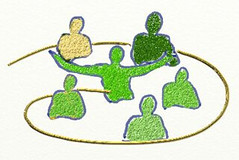 The Support Circle (3-5 people) is the innermost, and consists of people you would seek help from in a crisis. The Support Circle (3-5 people) is the innermost, and consists of people you would seek help from in a crisis.
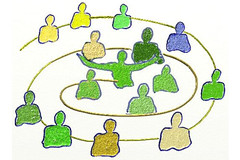 The Sympathy Circle (7-20 people, with a median of 10-15) are those whose death you’d find devastating, people you really care about. The Sympathy Circle (7-20 people, with a median of 10-15) are those whose death you’d find devastating, people you really care about.
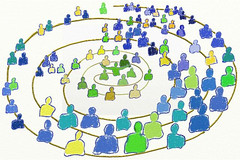 The Trust Circle (40-200 people, with a median of about 120) are those people you trust and have strong personal ties with (you’d miss them if you/they ‘moved away’). The Trust Circle (40-200 people, with a median of about 120) are those people you trust and have strong personal ties with (you’d miss them if you/they ‘moved away’).
The Emotional Circle (median size of just under 300 people) are those people you have “weak ties” to, i.e. some kind of probably non-reciprocal ‘liking’ for. You’re probably familiar with ‘The Strength of Weak Ties‘ and the importance of this peripheral group of people in helping you find the people and opportunities that will have a dramatic effect on your life and happiness.
Christopher also refers to a group called ‘familiar strangers’, people you recognize but don’t know.
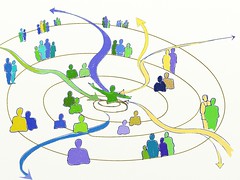
Taken together, these circles form a ‘topology’ that Christopher describes as follows:
Think of these circles as the ridge lines of a topographical map. An individual sits at the center, and around him lie many other people, fading slowly away as the distance increases. Winding through these topographical lines, like forests or rivers, are geographies of physical and emotional connection.
Kin are one of the most interesting geographies, because they lie all across the map. There’s a clump of them in the innermost circles, but there are also many who lie in the realm of Familiar Strangers, including those cousins and great-aunts who you only see at family gatherings, and whom you know nothing about. There are also forces being exerted upon the circles, acting like gravity to draw people together. Turning to community sizes:
 Working Groups (optimally 4-9 people, with a median of 7): Many studies suggest this size is optimal for communication, collaboration, and decision-making. Also works well for dinner parties and poker games. Beyond 9 and up to 25 members, groups get increasingly dysfunctional (12-15 is worst, so think twice about gathering your whole Sympathy Circle together for any purpose). Working Groups (optimally 4-9 people, with a median of 7): Many studies suggest this size is optimal for communication, collaboration, and decision-making. Also works well for dinner parties and poker games. Beyond 9 and up to 25 members, groups get increasingly dysfunctional (12-15 is worst, so think twice about gathering your whole Sympathy Circle together for any purpose).
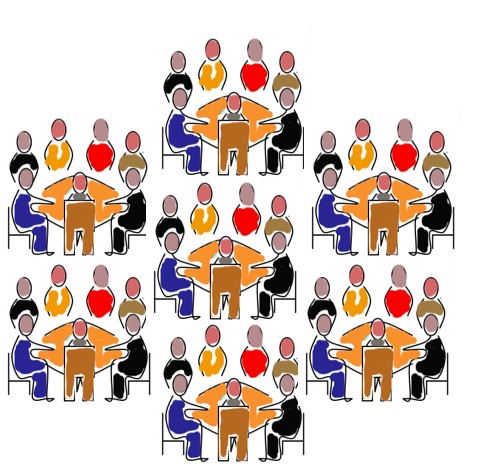 Enterprise Groups (optimally 25-75, with a median of 50): An enterprise is a systemic activity, a mutual undertaking with a common objective or focus of interest. This is the optimal size for guilds, associations, business enterprises, ‘unconferences’ and social networks — you get diversity and the ‘wisdom of crowds’ and critical mass for action, but the group is still self-manageable. Christopher calls this the ‘non-exclusive Dunbar number’ because such groups rarely have sufficient cohesion to attract anyone’s full-time or life-long energies. Beyond 75, groups again become increasingly dysfunctional, until, beyond the ‘official’ Dunbar number of 150, the geometrically increasing work needed to try to sustain any real cohesion, trust and participation outweighs the so-called ‘economies of scale’. Enterprise Groups (optimally 25-75, with a median of 50): An enterprise is a systemic activity, a mutual undertaking with a common objective or focus of interest. This is the optimal size for guilds, associations, business enterprises, ‘unconferences’ and social networks — you get diversity and the ‘wisdom of crowds’ and critical mass for action, but the group is still self-manageable. Christopher calls this the ‘non-exclusive Dunbar number’ because such groups rarely have sufficient cohesion to attract anyone’s full-time or life-long energies. Beyond 75, groups again become increasingly dysfunctional, until, beyond the ‘official’ Dunbar number of 150, the geometrically increasing work needed to try to sustain any real cohesion, trust and participation outweighs the so-called ‘economies of scale’.
So what does all this mean for social networking, blogging, twittering, Natural Enterprise, intentional community, the future of work, etc.? Here are Pollard’s Hypotheses of Social Cohesion, so far hypothetical, except insofar as I’ve observed the dynamics in a lot of workplaces:
- If we want business to be agile, resilient and innovative, we should break all organizations down into small, autonomous enterprises, ideally with no more than 75 people each, and ideally focused on the local community they’re a part of, where their people and customers live (physically, or, if the product is made of bits rather than atoms, virtually). There really are no ‘economies of scale’ beyond this size.
- As we move towards the World of Ends, more and more production will be Peer Production, and stuff will be made by networks of innovative small enterprises and Working Groups, not by large corporations. I describe how that will work here.
- The project teams I have worked on that have accomplished the most per-person per-hour have had memberships hovering around 7 or 50, with the smaller size (7) working best for short-term focused projects and projects that have a lot of shared and enduring passion among the members, and the larger size (50) working best for more ambitious, open-ended problem-solving projects where passion is more diffused or the members don’t know each other well. My guess is that Open Space events would work best with groups of about 50, though I may be wrong.
- Indigenous ‘uncivilized’ cultures generally had clans similar in size to the optimal Enterprise Groups, and gatherer-hunter groups similar in size to the optimal Working Groups. But because their ‘world’ of possible contacts was so much smaller than ours their Emotional Circle and Trust Circle would have been the same group, and that probably would have allowed them the ‘bandwidth’ to have a larger Sympathy Circle and Support Circle as well — in fact all four might have been the same, their ‘tribe’ or ‘clan’. So they would have had no need for nuclear ‘families’ or for an inner circle of ‘intimate’ friends for sympathy and support. I think one of the challenges of intentional communities is that some members, perhaps ‘naturally’, expect them to be the Support, Sympathy, Trust and Emotional Circle all wrapped up in one — unrealistic in our modern society. Perhaps intentional communities need to plan to create cohesive Support and Sympathy Circles within their membership, while encouraging the whole community to become a Trust Circle, so that they can expand beyond the Sympathy Circle size most seem to be stuck at.
- My ‘Gravitational Community’ listed on the right sidebar of this blog, and the number of people I’m in regular two-way contact with (mostly as a result of my blog), and the number of people I follow on Twitter, all seem to be converging on 70-80 people, with about 40 of them ‘hard core’ and the others ever-changing, entering and leaving my orbit as I enter and leave theirs. There is substantial gravitational pull in these networks, with many of the members likewise connected to each other. These are people I think I would like to live in community with. I think this is personal, social Trust Circle gravity. My guess is that, for most people, a manageable Trust Circle is closer to the low end than the high end of the 40-200 range and below the 120 median. As I’ve spent more and more time online I think the ‘quality’ of these friendships (congruence of interests, mutual knowledge and respect) has grown even though fewer and fewer live in my physical neighbourhood. I acknowledge, however, that it’s hard (and sometimes risky) to move ‘virtual’ relationships into your Support and Sympathy Circles.
We are social creatures at heart, and increasing our understanding of social cohesion and group effectiveness is important, for our personal happiness and ability to live peacefully with each other, and to help us to find meaningful, productive work as our current economy crumbles. What does the topology of your various social networks and work communities look like?
And what could we do, instead of herding people into anonymous housing subdivisions and indifferent hierarchical corporations, to better reflect our desire for self-selected social connection and to improve our work effectiveness?
Top 4 drawings, taken from Christopher’s site, drawn by Nancy Margulies.
Postscript: Christopher is planning another article in this series, this time on power laws, and what happens when some members of groups are more equal than others.
|

 The
The  The
The  The
The 






Except that – averages don’t apply to individuals, and can be harmful when prescribed.My own circles, for example, are much smaller than these averages. More than a very small number of people, and I get agitated.All of which means that membership is as important as group size. The number of participants is only one variable – and probably not a particularly important one. It may be easiest to quantify, but it would be a mistake to build organizational structure based on it.
Interesting that an article like this doesn’t include words like “friends” or “family”.And that “people you really care about” is used instead of “people you love”…
Right on, Dave. There is a great deal of misinformation out there about Dunbar’s number. Dunbar’s number is the upper limit of what works, and by the time you get close, you are spending all your time in social grooming just to keep things together. What works best is 45-65 adults for a community or enterprise.The ancient communities that work, for example Anabaptists, keep things down to 25-30 families and hive off a new church district when things get past that. (The Amish have a cute way of getting a felt sense of that… they meet in each other’s houses, and when things get just too crowded, time to make a new group.)I think one mistake Earthaven made was to shoot for Dunbar’s number, and then, trying to extend it to 180 (more money for the community, more stuff going on). It did not feel very cohesive there at all. Better to make an alliance of three villages of 60.
Very interesting. The numbers (especially for effective working groups) do seem a bit big to me, but the general premise seems really sound. I agree with what you say in point (3) of your final list.
http://springwise.com/weekly/2009-03-12.htm#wannastartacommunehttp://www.wannastartacommune.com/Looks good but why $3 for the pamphlet? Seems like just asking for donations would have a better result.